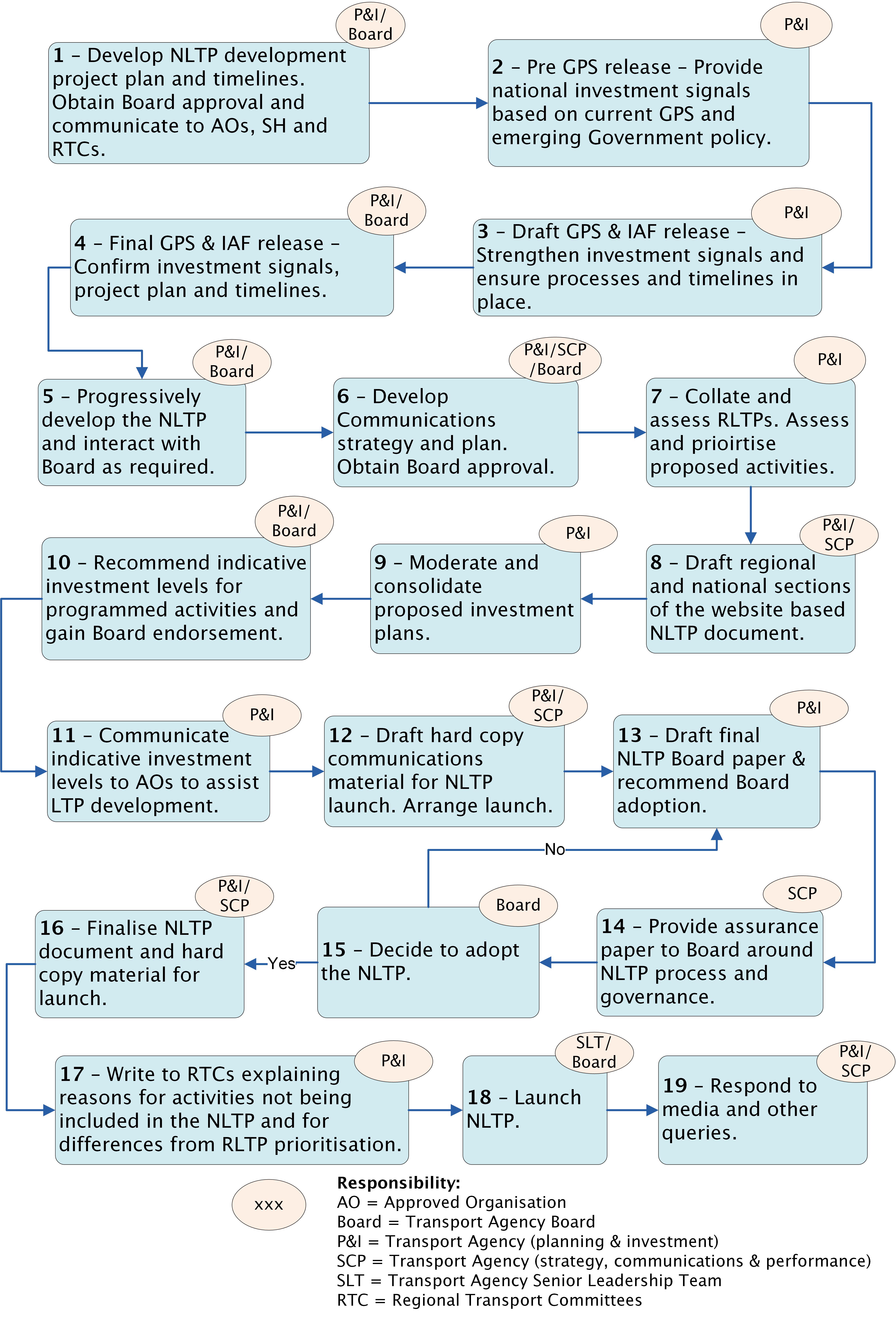Archive - this information is for reference only and no longer maintained.
This page relates to the 2018-21 National Land Transport Programme.
The National Land Transport Programme (NLTP) is developed every three years and is a key means by which Waka Kotahi NZ Transport Agency gives effect to the latest Government Policy Statement on land transport (GPS), which is also developed and reviewed on a three year cycle. The NLTP provides contextual information on national and regional issues, priorities and proposed activities. It prioritises the activities proposed for investment from the National Land Transport Fund over a three year period.
This is general information about developing programmes for the NLTP. You can find specific information about development of the forthcoming NLTP at the Waka Kotahi planning and investment news page. This includes information on timelines and key dates.
Planning and investment news
Legislative requirementsBack to top
Legislative requirements for developing the NLTP are set out in section 19 of the Land Transport Management Act (LTMA).
Section 19 – Land Transport Management Act(external link)
Additional guidance materialBack to top
For the development of each NLTP, Waka Kotahi prepares guidance material additional to the guidance in this Knowledge Base to clarify Waka Kotahi expectations of programme and RLTP development and review and to provide specific detail relevant to the development of the next NLTP.
The additional guidance for the 2018–21 NLTP can be found on the National Land Transport Programme page. This resource will be updated as new guidance is drafted as the NLTP is developed.
National Land Transport Programme
Development of the NLTPBack to top
The development of the NLTP follows the general process set out below. This reflects the pre July 2017 structure of Waka Kotahi and will be updated in due course.

Process steps for NLTP developmentBack to top
- Waka Kotahi develops the project plan and timelines for NLTP development. Board approval is obtained for the high level plan and deadlines and these are communicated to regional transport committees, approved organisations and Waka Kotahi.
- Prior to the release of the draft GPS, Waka Kotahi develops and communicates national investment signals based on the current GPS and emerging government policy.
- On release of the draft GPS and development of its draft Investment Assessment Framework, Waka Kotahi strengthens its investment signals and ensures that RLTP development and other processes and timelines are in place to meet its NLTP deadlines.
- On release of the final GPS and Investment Assessment Framework, Waka Kotahi confirms its NLTP project plan, investment signals and timelines, and obtains board approvals as required.
- Waka Kotahi progressively develops the NLTP and interacts with the board as necessary, providing updates and obtaining direction.
- Waka Kotahi develops its NLTP communications strategy and plan, and obtains board high level approval of these.
- Waka Kotahi collates and assesses RLTPs and assesses and prioritises the activities proposed for inclusion in the NLTP.
- Waka Kotahi drafts up the national and regional sections of the electronic NLTP document on the Waka Kotahi website.
- Waka Kotahi moderates and consolidates investment proposals with particular emphasis on programmed activities (maintenance, public transport services, promotion of road safety).
- Waka Kotahi recommends indicative investment levels for programmed activities and obtains the board's endorsement to these. The purpose is to provide approved organisations and Waka Kotahi (state highways) more certainty around the funding they will receive to assist development of their budgets and plans.
- Indicative investment levels for programmed activities are communicated to approved organisations to assist their long term planning.
- Waka Kotahi drafts hard copy supporting information for the launch of the NLTP and makes arrangements for the national and regional launches.
- Waka Kotahi drafts the NLTP board paper and recommends adoption of the NLTP.
- Waka Kotahi drafts a paper for the board to provide assurance around the process followed to develop the NLTP and around the board's governance role.
- The board decides whether to adopt the NLTP. If it decides not to adopt the NLTP, the process goes back to step 13 to redraft the board paper to take account of the board's concerns.
- If the board adopts the NLTP, Waka Kotahi completes drafting of the NLTP document on its website. It also completes the hard copy supporting documentation for the national and regional launches.
- Waka Kotahi writes to regional transport committees (and affected approved organisations) explaining the reasons why activities have not been included in the NLTP and why the Waka Kotahi priority order for activities differs from the RTCs' order.
- The board and the Waka Kotahi senior leadership team launches the NLTP nationally (Wellington based and involving sector leaders and media) and regionally (involving regional leaders, eg mayors, chief executives, etc).
- During and after the launch, Waka Kotahi staff respond to media and other queries for information relating to the NLTP, including parliamentary and ministerial queries.
Timelines for NLTP developmentBack to top
Every three years, Waka Kotahi is required under the LTMA to adopt the NLTP by 1 September of the first year of the NLTP under development. The GPS is finalised about a year ahead of this so that there is time to develop RLTPs and an NLTP that will give effect to it.
In most cases we aim to adopt the NLTP by 30 June of the financial year immediately preceding the start of the NLTP. For example, if the 2021–31 GPS is finalised in July 2020, the NLTP would be adopted 30 June 2021, and both would be in effect from 1 July 2021.
There may be times when the development of the NLTP is delayed, eg due to late release of the GPS, and in these cases we have until 31 August of the first year of the NLTP to adopt the NLTP – and may adjust the deadlines for RLTPs as a consequence.
